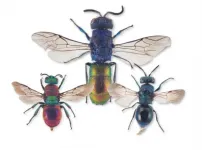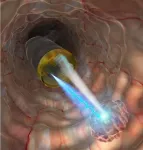(Press-News.org) Cuckoo wasps - also called emerald wasps - are some of the most beautiful insects we have, with colourful exteriors that shine like jewels. However, these beauties have also created a lot of headaches.
"Normally we distinguish insects from each other by their appearance, but cuckoo wasps are so similar to each other that it makes it difficult," says Frode Ødegaard.
Ødegaard is an insect researcher at the NTNU (Norwegian University of Science and Technology) University Museum and belongs to the European research group that has now described thia recent contribution to species diversity. The new species is very rare, and is only a single specimen has been found on the Lista peninsula in Agder county in Norway.
For more than 200 years, insect researchers have struggled to sort cuckoo wasps into the right "species boxes," and to determine which characteristics are variations within a species and which are species-specific differences.
In the last 10 years, DNA barcoding has brought about a major breakthrough by making it possible to distinguish different species of cuckoo wasps from each other by looking at the differences in their genetic material.
"But it's not always that easy, either. In this case, we had two cuckoo wasps with microscopic differences in appearance and very small differences in DNA," Ødegaard says.
"The next step was to look at the language of each of the wasps to find out if they belonged to different species," he says.
Insects communicate with each other through pheromones - in other words, they have a chemical language. Very closely related species often have completely different languages to prevent them from interbreeding.
The cuckoo wasp is an insect with above-average linguistic abilities. They are parasites, which means that they behave like cuckoos and lay their eggs in the nests of other bees and wasps. The larvae grow quickly and hatch before the host's eggs. Then they eat the eggs, the larvae and the food supply that the host has arranged in the nest.
"When you live as a parasite, it's important not to be discovered, and therefore the cuckoo wasp has also learned the language of its host," says Ødegaard.
By conducting an ever-so-small language study, the researchers were able to discover that the two almost identical cuckoo wasps did indeed belong to different species. They use different hosts - and that means that they also speak completely different languages.
"The evolutionary development associated with sponging off another species happens very fast. That's why you can have two species that are really similar genetically but still belong to different species," says Ødegaard.
When a new species is described it has to be given a name, and Frode Ødegaard had the good fortune to receive the honour of naming the newcomer.
"A naming competition was announced among researchers in Europe who work with cuckoo wasps, and then the proposals that came in were voted on. It turned out my proposal actually got the most votes!" Ødegaard says.
"As mentioned, the new wasp is very similar to another species called Chrysis brevitarsis, so the new species was named Chrysis parabrevitarsis, which means 'the one standing next to brevitarsis'."
Ødegaard was also responsible for giving the species its slightly simpler Norwegian name of sporegullveps. He makes no secret of the fact that he found it great to be able to name a new species.
"In a way, you place yourself in the perspective of eternity, because that species will always have that name. There's something very fundamental about it."
The only known specimen of this cuckoo wasp has been captured and pinned in an insect collection. So it may seem both morally reprehensible and unnecessary that this one lone individual was stuck onto a needle.
"Even with today's advanced methods, using live animals for studies like this isn't possible, but collecting individual specimens fortunately has no impact on the population," Ødegaard says.
"The insects have enormous reproductive potential, and the size and quality of the habitats are what determine the viability of the population, not whether any specimens are eaten by birds or collected by an insect researcher."
He adds that the collected insects are absolutely crucial for researchers to be able to map and describe their diversity and thus take care of viable populations for posterity.
INFORMATION:
You can read more about how Frode combines his role of mass murderer and conservation biologist in his blog (in Norwegian): http://www.beetlebee.me/
Reference: Frode Ødegaard et al: Cuticular Hydrocarbon Profile Analyses Help Clarify the Species Identity of Dry-Mounted Cuckoo Wasps (Hymenoptera: Chrysididae), Including Type Material, and Reveal Evidence for a Cryptic Species Insect Systematics and Diversity, Volume 5, Issue 1, January 2021, 3, https://doi.org/10.1093/isd/ixab002
New research suggests Ireland's increasing populations of Sika deer may be linked to local outbreaks of TB infection in cattle.
Although TB infection rates have decreased in general in recent decades, county-level data shows a correlation between higher Sika numbers and higher local TB infections - with County Wicklow a particular hotspot.
The research, conducted by researchers from Trinity College Dublin and the National Parks and Wildlife Service and supported by the Department of Agriculture, Food and the Marine, has major implications for controlling TB. It has ...
Is there a way to chemically manipulate small, confined areas on cellular surfaces? Scientists have developed a microfluidic probe to send a flow of free radicals on live cells and track the outcome using fluorescence imaging. As outlined in the journal Angewandte Chemie, this approach makes it possible for the first time to generate a reaction zone of free radicals with controlled size and concentration for subcellular research.
Free radicals are important stimulants for cells. When live cells are exposed to radicals, they develop intense reactions that can lead to cell ...
Researchers at Tokyo Institute of Technology (Tokyo Tech) have experimentally demonstrated a novel cancer diagnosis technique based on the scattering of circularly polarized light. Computational studies revealed that this technique can detect the progression of precancerous lesions and early cancer. This method can be implemented using an endoscope equipped with spin-LEDs--devices that emit circularly polarized light.
Most cancers of the digestive system emerge in the surface layer first and then progress into deeper layers. While surface layer carcinomas can be readily treated using an endoscope, carcinomas that have advanced onto deeper layers need surgical intervention to prevent them from metastasizing to lymph nodes or other organs. Thus, accurate measurements of the depth of cancer ...
Amsterdam, April 6, 2021 - The rarity of spinal muscular atrophy (SMA) means that promising new treatments may be tested in only a limited spectrum of patients before approval. Investigators evaluated a newly approved drug, onasemnogene abeparvovec, in a broader spectrum of patients in order to obtain expanded data on its side effects profile. They report in the Journal of Neuromuscular Diseases that the drug is associated with an immune response against the adeno-associated viral vector and needs careful monitoring, but showed no long-term adverse effects.
In recent years, the availability of a growing number of drug treatments has significantly ...
New Orleans, LA - A study led by Edward Wojcik, PhD, Associate Professor of Biochemistry & Molecular Biology at LSU Health New Orleans School of Medicine, identified how microcephaly (abnormally small heads) and blindness may develop in Zika-infected fetuses, as well as a new way to potentially prevent these neurodevelopmental defects. The results are published online in iScience, available here.
The mechanism by which Zika virus disrupts neuronal development and results in congenital Zika syndrome was unknown. Because of similarities between Zika syndrome and a recognized congenital genetic disease (Kinesin-5) known to cause microcephaly and retinopathies in developing infants, the research team studied both, looking for similarities. They discovered a direct link, the first ...
Comparison of coda waves, the scattered waves that arrive after the direct waves of a seismic event, can be used to determine the relative locations of two underground explosions, according to a new study published in the open-access journal The Seismic Record.
The technique, called coda wave interferometry, was tested on explosions conducted as part of the Source Physics Experiment (SPE). Lawrence Livermore National Laboratory researchers Sean Ford and Bill Walter report that coda wave interferometry can also put a limit on the extent of damage caused by an explosion.
The findings suggest the technique could be used to improve the estimates of the relative locations ...
Using samples of small cell lung tumours, a research team led by biologist Dr Silvia von Karstedt has discovered two new ways to induce tumour cell death. One of two subsets of tumour cells can be targeted by activating ferroptosis: iron-dependent cell death caused by oxidative stress. In the second subtype, oxidative stress - and hence cell death - can also be induced in a different way. Both types of cell death must be triggered simultaneously by drugs to kill the majority of the tumour mass. The results of the study have been published in Nature Communications.
Despite many advances in treatment, a diagnosis of small cell lung cancer means a particularly poor prognosis. In Germany, up to 8000 new cases ...
DURHAM, N.C. -- Some guys have it all: the muscle, the power, the high social status, the accelerated aging.
But wait. Faster aging? Who wants that? For male baboons, it's the price they pay to be at the top.
New research appearing April 6 in eLife by Jenny Tung, associate professor of evolutionary anthropology and biology at Duke University, and her colleagues shows that male baboons that climb the social ladder age faster than males with lower social standing. If a male drops in social status, his estimated rate of aging drops as well.
Using blood samples from 245 wild baboons in the ...
TAMPA, Fla. -- Tumors are genetically diverse with different mutations arising at different times throughout growth and development. Many models have tried to explain how genetic heterogeneity arises and what impact these alterations have on tumor growth. In a new article published in Nature Communications, Moffitt Cancer Center researchers show how the location of the tumor and spatial constraints put on it by the surrounding tissue architecture impact genetic heterogeneity of tumors.
Genetic differences are apparent among tumors from different patients, as well as within different regions of the same tumor of an individual patient. Some of these mutations may benefit the tumor and become selected for, such as mutations that allow the tumor to grow faster and spread to other ...
NASA's Hubble Space Telescope is "seeing double." Peering back 10 billion years into the universe's past, Hubble astronomers found a pair of quasars that are so close to each other they look like a single object in ground-based telescopic photos, but not in Hubble's crisp view.
The researchers believe the quasars are very close to each other because they reside in the cores of two merging galaxies. The team went on to win the "daily double" by finding yet another quasar pair in another colliding galaxy duo.
A quasar is a brilliant beacon of intense light from the center of a distant galaxy that can outshine the ...






